Ed Gorman's Blog, page 179
November 23, 2011
The Collected Nathan Heller Short Stories $0.99

Ed here: The writer who gave us Road To Perdition, the Nathan Heller novels and so many other fine books
has put his Nathan Heller short stories into a great new collection. Classic hardboiled stories that readers of every kind will enjoy. One of my favorite books of the year.
Start reading Chicago Lightning: The Collected Nathan Heller Short Stories on your Kindle in under a minute. Don't have a Kindle? Get your Kindle here.
Buy for $0.99
http://www.amazon.com/gp/product/B005...
Published on November 23, 2011 09:08
November 22, 2011
New eBooks: Kill Them All by Harry Shannon

Kill Them All (Dead Man #6) [Kindle Edition]
Harry Shannon (Author), Lee Goldberg (Author), William Rabkin (Author)
Digital List Price: $2.99 What's this?
Prime Members: $0.00 (read for free)
Kindle Purchase Price: $0.99
When Purchased, You Save: $2.00 (67%)
Q&A With Harry Shannon, author of Kill Them All
Q: How did you become a novelist?
HS: I adore books, always have. The itch to write one has always been there. Like a lot of authors, I've worked at a number of professions over the years, from music publisher and song lyricist to film executive and psychological counselor. I'd always intended to try my hand at a novel someday, perhaps after retirement, but when my daughter was born so was the necessary drive. I figured, why wait? So I began to outline my first Mick Callahan mystery Memorial Day. It was published two years later.
Q: How did you get involved in The Dead Man series?
HS: In 2010, several experienced authors joined me in forming a loose organization called Top Suspense Group. Among them was Lee Goldberg, who co-created The Dead Man series. Lee asked me if I'd be willing to contribute a novella. Since I grew up on Gold Medal novels, Lancer books and other men's pulp fiction, I loved the concept and jumped at the chance. It was a wonderful experience, and now I'm looking forward to seeing how readers react to my take on Matt's character.
Q: You've written a lot of horror books, including Clan, The Hungry and the Lionsgate movie and novel Dead and Gone. How is the horror in The Dead Man different from what you have done before?
HS: That's an interesting question. For me, horror is not a genre so much as an emotion, so it can be expressed in any number of ways. I generally gravitate towards dry humor coupled with a serious exploration of existential themes--literally the meaning of life, death and those fragile emotional attachments we form along the way. With my entry Kill Them All, I wanted to use the horror as a metaphor for moral corruption. I immediately saw Matt as the classic American hero, an archetypal loner wandering into and out of a troubled desert town, standing up to evil on behalf of the weak and downtrodden. I often set novels in Nevada, but to answer your question, this one has the feeling of a graphic novel, and though it's contemporary it is far more of a classic western than anything else I've ever done. It tempts me to try my hand at a period piece.
Q: This is the first time you've written in someone else's "universe." What was it like writing characters you didn't create?
HS: To be honest, it wasn't easy at first. I'm not used to having to discipline my muse to that degree. Lee Goldberg and William Rabkin were very patient with me, red-lining and sending back a couple of drafts, pointing out where I'd gotten something wrong about Matt's personality or background. The tone had to be just right, and my goofiness had to be reigned in a bit. Kill Them All ended up far, far better as result of their patience. I'll have to prepare and outline more carefully the next time I do a project like this. But once the boundaries were nailed down properly, it just started flowing out. I'm proud of i>Kill Them All. It has substance to it, and was lots of fun to write.
Q: What you've written in so many genres. What genre do you like best?
HS: Like most of the folks contributing to The Dead Man series, I'm very comfortable wandering the boundary between horror and crime fiction and occasionally blurring the line between the two. And I do love a good western. If forced to choose just one genre, I'd say my heart is in the mystery/thriller, where supernatural elements aren't present, but human evil certainly is. My character Mick Callahan is a troubled young psychologist with anger problems. I work a lot of my own issues out when writing Callahan books. There are plenty of horrific moments in his life, though none involving zombies or ghosts. I enjoy exploring Callahan's inner world.
Q: Is there a common strain that runs through your writing regardless of whatever genre you're writing in?
HS: Another interesting question. The short answer is yes. Doing the right thing. I am drawn to stories that use temptation and terror to force a protagonist to examine his or her own character. My favorite definition of the word integrity is "obedience to the unenforceable." Okay, you could get away with doing this, but could you live with it? I also believe the old saw "all that is necessary for evil to triumph is for a good man to do nothing." I'm always working to understand my own conflicting impulses and drives, and believe that very human struggle to be a noble endeavor. I'm sure all that comes out in my writing, book after book, and that it's also there in Kill Them All.
Q: What are you working on now?
HS: I'm hard at work on a new Mick Callahan thriller, tentatively entitled Rough Men. I'm also toying with a crime novella for Top Suspense Group, and a sequel to my zombie apocalypse novel The Hungry. So there you go, I'm writing a mystery, a thriller, and a horror novel!
Product Description
Matt Cahill was an ordinary man leading a simple life until a shocking accident changed everything. Now he can see a nightmarish netherworld that exists within our own. Now he's on a dangerous quest for the answers to who he is and what he has become...and engaged in an epic battle to save us, and his soul, from the clutches of pure evil.
When Matt wanders into a struggling Nevada tourist trap recreation of an "old west" town, he's unaware that he's being trailed by a Special Ops team of professional mercenaries hired by a University desperate to unlock the secret behind his resurrection...and that he's put everyone around him in dire jeopardy. The mercenaries have no intention of letting Matt escape...or letting any witnesses survive. Matt finds himself in a deadly bind. Somehow he must rally the peaceful citizens into defending themselves against the sadistic, well-armed mercenaries… or sacrifice himself to save them from certain death.
The Dead Man Series:
Face of Evil by Lee Goldberg & William Rabkin
Ring of Knives by James Daniels
Hell in Heaven by Lee Goldberg & William Rabkin
The Dead Woman by David McAfee
The Blood Mesa by James Reasoner
Kill Them All by Harry Shannon
The Beast Within by James Daniels
See all Editorial Reviews
Published on November 22, 2011 15:09
New from Haffner Press: Shannach – The Last: Farewell to Mars Leigh Brackett
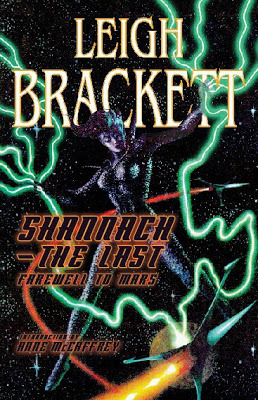
Shannach – The Last:
Farewell to Mars
Leigh Brackett
Introduction by Anne McCaffrey
Illustrated by Ed Emshwiller and Frank Kelly Freas
ISBN 9781893887442
$40.00
500+ pages Hardcover
Description
Picking up where Lorelei of the Red Mist: Planetary Romances left off, this volume collects the final 17 stories of strange adventures on other worlds from the undisputed "Queen of Space Opera." Drawn from the last years of pulp magazines such as Planet Stories, Startling Stories, and Thrilling Wonder Stories, Shannach – The Last: Farewell to Mars sees Brackett at the peak of her talents. Oddly, it is at this point where she abandons the "planetary romance" sub-genre and embarks on a small string of stories tinged with social relevance. This departure didn't stop editors asking for some of "that old Brackett magic" and she offered up two latter day tales ("The Road to Sinharat" and "Purple Priestess of the Mad Moon") before returning to chronicle further adventures of Eric John Stark in her final "Skaith" novels. Closing out the collection is a trio of tales written on commission from the "king of anthologies," Roger Elwood.
The book is adorned with Frank Kelly Freas' and Ed Emshwiller's vintage illustrations from the original pulp magazines.
In a review of Lorelei of the Red Mist: Planetary Romances Paul di Filippo says "[Brackett's work] is replete with hard-bitten protagonists with wounded psyches, females both nurturing and malevolent, weird alien life forms, strange planetary environments, danger, treachery, camaraderie and even spiritual epiphanies. In short, this book holds the essence of SF—at least, the essence of one very important school of it."
Yeah, that's the stuff!
Table of Contents
Reviews
Excerpts
Related Books
Martian Quest
Lorelei of the Red Mist
Stark and the Star Kings
Table of Contents
"Introduction" by Anne McCaffrey
The Truants (Startling Stories Jul '50)
The Citadel of Lost Ages (Startling Stories Dec '50)
The Woman from Altair (Startling Stories Jul '51)
The Shadows (Startling Stories Feb '52)
The Last Days of Shandakor (Startling Stories Apr '52)
Shannach—the Last (Planet Stories Nov '52)
Mars Minus Bisha (Planet Stories Jan '54)
Runaway (Startling Stories Spr '54)
The Tweener (The Magazine of Fantasy and Science Fiction Feb '55)
Last Call from Sector 9G (Planet Stories Sum '55)
The Queer Ones (Venture Mar '57)
All the Colors of the Rainbow (Venture Nov '57)
The Road to Sinharat (Amazing Stories May '63)
Purple Priestess of the Mad Moon (ss) F&SF Oct '64)
Come Sing the Moons of Moravenn (The Other Side of Tomorrow, ed. Roger Elwood, 1973)
How Bright the Stars (Flame Tree Planet, ed. Roger Elwood, 1973)
Mommies and Daddies (Crisis, ed. Roger Elwood, 1974)
"Afterword" by Leigh Brackett
Published on November 22, 2011 06:18
November 21, 2011
NEW BOOK: ASK THE DICE by Ed Lynskey
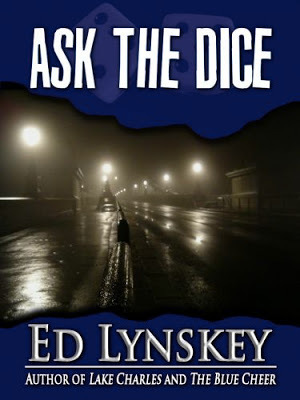
NEW BOOK: ASK THE DICE by Ed Lynskey
November 2011. Crossroad Press.
Digital List Price: $3.99
Ask the Dice is my new crime noir written in the brisk, lean tradition of the classic Fawcett/Gold Medal PBOs. Ask the Dice is my second stand-alone novel after Lake Charles.
Middle-aged Tommy Mack Zane, an ace hit man for organized crime, is looking forward to retiring from the grisly profession and going to live out his golden years. His crime boss catches wind of Tommy Mack's plans and seemingly sets him up for the murder of the rebellious crime boss's niece. No choice, Tommy Mack takes it on the lam and with the aid of a few solid friends battles his vengeful crime boss. And who couldn't use a few solid friends in a jam like his?
When I decided to use the hit man trope from crime fiction, I wanted to create mine as distinctive but without going over the top with his character. Tommy Mack is a black kid adopted by a white family in the Washington, D.C. suburbs. His early childhood spent in rural Texas figures predominantly in determining his career. A lover of jazz and poetry, he pursues outside interests, and therefore he enjoys a life outside of his job. In other words, he feels ready to something else besides bumping off marked victims for his crime boss who insists, "It's just business."
The use of back-story in crime fiction has somewhat fallen out of vogue, but for me it remains essential. Tommy Mack's past makes him the unsympathetic protagonist he is, but the back-story also fleshes out just why he takes up his assassin trade. By the climax, he unearths a few nasty surprises and deals with them in his way.
Ask the Dice has its own noirish roots. The title is derived from a Marilyn Monroe quote to the director John Huston at the Reno craps table in Spring 1960, during the filming of The Misfits, her final motion picture. She's a film noir starlet from her incandescent presence in The Asphalt Jungle while Huston's contributions to the genre are legendary.
Thanks for your interest in Ask the Dice, and to Ed for having me back again.
Kindle users: http://tiny.cc/0fqpp
Nook users: http://tiny.cc/lddk5
-Ed Lynskey
Twitter: @edlynskey
Published on November 21, 2011 07:23
November 20, 2011
Still hanging in there on Baker & Taylor Top 15 at #9From...
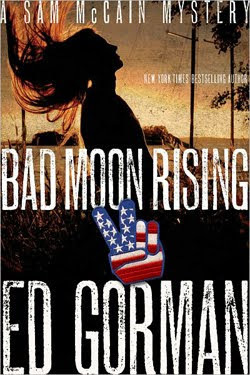
Still hanging in there on Baker & Taylor Top 15 at #9
From author Charlie Stella Temporary Knuckline
The Sam McCain mysteries are always fun for this reader; partly because they are always historical novels and partly because they're always so well written. Bad Moon Rising is no exception. The Gorman-McCain formula touches on nostalgia and easily identifiable landmarks along a familiar timeline. The fact Gorman has been doing this longer than my married kids are alive is no fluke; he's survived where many authors haven't. Bad Moon Rising offers the usual cast of Black River Falls fun and interesting characters, plus a few new ones, and a plot that twists as good as any. A reader choosing any one of the series will be well invested in Sam McCain before they know it.
Having read a few of the McCain series, I was smiling and nodding as soon as I came across an early passage where Sam mentions the Sitar (and how mostly annoying it is to have to listen to one—music to torture one's ears has always been my definition). It is that sense of timeline/nostalgia/Americana (so what Ravi Shankar was Indian? I remember being tortured by his sitar at the Concert for Bangladesh in Madison Square Garden).
And let's face it ... people went to the bathroom in masses when two things happened back in the day ... Ravi Shanker took the stage or a twenty-minute drum solo began.
Gorman presents what many of us assume are the good old days while always reminding us there was some bad days as well; Vietnam, long awaited civil rights legislation waiting to take hold, etc.. In Bad Moon Rising, McCain is confronted with the death of the daughter of a wealthy libertarian of sorts. Paul Manwearing was recently widowed and quickly remarried but the stepmom to his two daughters is well versed in remarrying. Paul's daughters were not happy with the new woman in their lives and each dealt with it in her own way; seeking attention from their father in self destructive ways—how kids in such situations often seek attention.
There's also a high school football star with very dysfunctional parents forever fighting one another (at the top of their lungs) making their home a place not to be. A multitude of potential suspects to the murder of Manwearing's daughter will keep you guessing throughout. There's a hippie commune that drives many of the good folk of Black River Falls somewhat crazy and preacher Cartwright does his usual fire and brimstone routine (something that drives Sam crazy throughout the series), but if there's anything missing (for this reader) from Bad Moon Rising, it is more of the back and forth between Sam and Judge Whitney (Sam's Republican Alter ego) … and if I'm not mistaken, she didn't even shoot a rubber band at him this go. A reformed Judge Whitney? Say it ain't so, Mr. Gorman.
Sam is always fun to read about and Bad Moon Rising is no disappointment to this wonderful series.
Published on November 20, 2011 12:53
November 19, 2011
New Books: Saboteur-Richard S. Wheeler Writing as Axel Brand

The Saboteur (Lieutenant Joe Sonntag Mysteries) [Kindle Edition]
Digital List Price: $2.99
A violent strike; murder at the factory gates.
Milwaukee, 1949. There's labor turmoil in Beer City. Joe Sonntag gets called to the strike-bound West Allis tractor factory, where a temporary employee has been shot and killed in the middle of the night. The struggle between the Machinists Union and the company has boiled over into murder.
But it proves to be more complex than that. The police soon find that mobsters are attempting to take over the union. And also they discover a romantic radical, Anastasia Ryan, who seems to be all too present when more people suddenly die of gunshot wounds, including a respected union leader. She can recite the poetry of John Donne, and lay yellow roses on the grave of an unnamed "scab." Who is she, and why is she there?
This is all a strange world for Joe Sonntag. He's used to dealing with crooks and thugs, but here are people fighting a war to the death over ideals, and jobs, and pay, and maybe the future of the world.
Joe's finest young detective, Frank Silva, who comes from a socialist family, confesses that he once had a romance with Anastasia. She was an experienced older radical; he was a teenager blotting up her beliefs and her world. Suddenly young Frank Silva becomes the lead detective, his bitter insights leading Sonntag's detectives toward the tangled and tragic truth.
Published on November 19, 2011 18:13
EXCITING NEW HARD CASE CRIME NOVEL
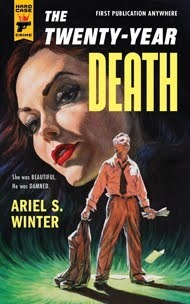
We just added a new book to the Hard Case Crime Web site (www.hardcasecrime.com), a first novel by a young Baltimore-based writer named Ariel S. Winter that we'll be publishing next summer. It's not the sort of book that generally attracts a lot of coverage merely as a result of being announced – obviously no one knows the author's name yet, since he hasn't published any books before. The main thing it does have going for it is that it's an amazing, amazing book – one that really knocked my socks off – but that's something no one else will appreciate until they actually get to read it, which is months away.
However –
There is another story here, which is the book's very unusual structure. The book is called THE TWENTY-YEAR DEATH, and it's the story of a husband and wife whose lives collapse as violence intrudes – not an unusual premise for a noir novel. But the form Winter chose for it is very unusual: he decided to tell the story of these two doomed characters in the form of three separate old-fashioned crime novels, each set in a different decade and written in the style of one of the iconic mystery writers of that time. It feels a little like opening a Christmas package and finding new novels by three of your favorite pulp-era crime writers. The first is set in 1931 and features a French police inspector investigating the death of a convict in a rain gutter 20 miles away from the prison where he was supposed to be serving a 40-year jail sentence. The second is set in 1941 and features a hardboiled private eye in Hollywood who is hired by one of the big movie studios to watch over one of their leading ladies, who either is showing signs of paranoid dementia or is actually being stalked by a mysterious man on the set of her new picture. And the third is set in 1951 and puts us deep inside the dark and troubled mind of a desperate man, a drunken writer who has lost almost everything he had and is about to tip over the edge separating 'troubled' from 'dangerous.'
What's more, these aren't just pastiches – what's wonderful is that each book works not only as a tribute to a great mystery writer of the past but also as a standalone novel with substance and emotional heft, and as part of the combined larger whole. It's fascinating, for instance, to watch a background character in the first book become a more central figure in the second and then the first-person narrator in the third. I don't know any other book that's ever done anything like it.
In any event…I fell in love with the book, and bought it even though it's three times the length of our usual books (by far the longest book we've ever published – 180,000 words), and even though you're always told, as a publisher, that first novels don't sell. I did it because it's a stunning performance and just left me grinning the widest grin I've had on my face for a long, long time.
I don't know if you'll want to run anything about it this early, but if you do, let me know and I can get you a high-res image of the cover art. (Painted by Chuck Pyle, it features the Hollywood star from the 1941 novel…and actual Hollywood star Rose McGowan posed for the painting!) If not, I'm glad to at least plant a seed in the back of your mind now, which will hopefully ripen into full-blown curiosity when we get closer to the book's publication date...
Best,
Charles
Published on November 19, 2011 10:44
November 18, 2011
Max Allan Collins makes one more 'Return to Perdition' USA TODAY
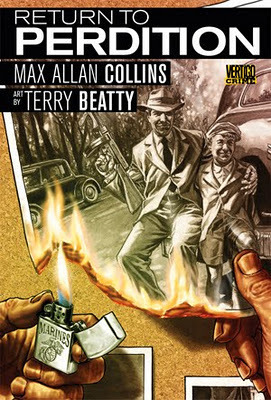
Max Allan Collins makes one more 'Return to Perdition'
By Brian Truitt, USA TODAY Updated 2d ago
After three graphic novels, two prose books and a Tom Hanks movie, Max Allan Collins' Road to Perdition saga is winding to a close — and a somewhat surprisingly peaceful ending.
The writer's 1998 graphic novel Road to Perdition introduced 1930s Mob enforcer Michael O'Sullivan, his young son, and their quest for revenge, and the new Return to Perdition, out now from DC Comics' Vertigo imprint, completes the tale with O'Sullivan's grandson, Michael Satariano Jr., who returns home from the Vietnam War in the 1970s to an equally violent life as a government assassin.
Collins' ambitious journey dates back to 1993. Working with his editor at DC's now-defunct Paradox Press, Collins initially envisioned three graphic novels of 300 pages each that would tell the adventures of O'Sullivan and his kid on the road, robbing banks and eluding gangsters a la The Fugitive.
He had started planning a sequel two-thirds of the way through Road when he heard that DC was cancelling the line, meaning he had to wrap his story up in the final 100 pages. In the meantime, he had been arguing with his editor about whether the series should simply be about the father and son, or a bigger generational saga like The Godfather.
"The more I thought about, the more I thought he had a good point," Collins recalls. "I mapped out the subsequent generations: The boy in Road to Perdition growing up, going to war, getting sucked into the Mob himself and ultimately having a son who similarly — primarily because of the role of vengeance in their lives — got drawn into thus life of crime."
for the rest go here: http://www.usatoday.com/life/comics/s...
Published on November 18, 2011 13:12
November 17, 2011
Forgotten Books: Conan Doyle, Detective by Peter Costello
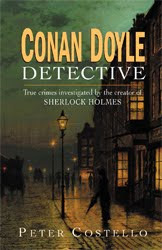
I always thought that Arthur Conan Doyle was a pretty cool guy. When I was young, I was all caught up in the almost otherworldly portrait he gave us of Victorian London and environs: the fog, the hansom cabs, the echoing footsteps down the dark alleys, the pitiful ones of Whitechapel, the self-indulgent ones of the aristocracy. And then when I got older and had more appreciation of what it was like for a father to lose a son, the way Doyle turned to mentalism of various sorts…
The one aspect of the Doyle story I'd never paid much attention to was his very real interest in true-crime cases. As Erle Stanley Gardner would do several decades later, Doyle helped clear innocents and thus helped them escape the gallows. And he worked with police from a variety of cities, towns and even other countries when they asked his opinion or advice on matters concerning open cases.
All this is documented in a fine new book CONAN DOYLE, DETECTIVE: THE TRUE CRIMES INVESTIGATED BY THE CREATOR OF SHERLOCK HOLMES by Peter Costello that moves as swiftly as a Doyle story while offering us a look at a Doyle most of us have ever encountered, even in some of the better Doyle biographies.
There are chapters on six of the UK's most famous cases, including Crippen, Jack the Ripper and the Irish Crown Jewels. Even when Doyle was wrong in his conjectures, his process of deduction is fascinating to follow. Likewise, even in cases of lesser fame, Costello sets all the crimes in a context that helps give us a vivid sense of the era.
A real treat for several audiences: those who love Holmes, those fascinated with Doyle himself, those interested in the formation of modern crime-solving techniques and those (and there seem to be many) who wished they'd lived in the time of Queen Victoria.
Published on November 17, 2011 14:41
November 16, 2011
Fight Card #1 Felony Fists by Jack Tunney
(I apologize for not having the excellent cover at hand. My computer will not cooperate in getting the image to reproduce. I apologize to Paul especially.)
As someone who grew up in the Forties and Fifties boxing fiction was almost as familiar to me as detective stories and westerns. Hollywood especially loved boxing material. Some of the movies were extraordinary but most were lame and predictable.
When I read about Paul Bishop's Felony Fists (under the name Jack Tunney) I wanted to read it because Paul is such a good writer and because he set his story in his hometown, Los Angeles in the historically interesting year of 1954 (Joe McCarthy, mob hearings in the Senate and Ike promising to end the Korean war one way or the other, including dropping the big bomb).
Felony Fists give us the era vividly and it also delivers a knock out story with the protagonist police officer (and amateur boxer) Patrick "Felony" Flynn.
Here's the Amazon description (I do this because a number of you have complained about my lax attempts at summarizing stories—apparently forgetting all the sacrifices I've made for this country).
"Patrick "Felony" Flynn has been fighting all his life. Learning the "sweet science" from Father Tim the fighting priest at St. Vincent's, the Chicago orphanage where Pat and his older brother Mickey were raised, Pat has battled his way around the world – first with the Navy and now with the Los Angeles Police Department.
"Legendary LAPD chief William Parker is on a rampage to clean up both the department and the city. His elite crew of detectives known as The Hat Squad is his blunt instrument – dedicated, honest, and fearless. Promotion from patrol to detective is Pat's goal, but he also yearns to be one of the elite.
"And his fists are going to give him the chance.
"Gangster Mickey Cohen runs LA's rackets, and murderous heavyweight Solomon King is Cohen's key to taking over the fight game. Chief Parker wants Patrick "Felony" Flynn to stop him – a tall order for middleweight ship's champion with no professional record.
"Leading with his chin, and with his partner, LA's first black detective Tombstone Jones, covering his back, Patrick Flynn and his Felony Fists are about to fight for his future, the future of the department, and the future of Los Angeles."
If I had to categorize Felony Fists I'd call it New Pulp. Yes it's fast paced, honors many pulp tropes and delivers everything pulp readers require but it's much more realistic than Old Pulp. For one thing Paul Bishop knows boxing and it shows. He also gives headline names like Mickey Cohen real life.
This is a story that just won't quit. I read it in two sittings and enjoyed every page. And all it cost me was $2.99. Next in the series is Mel Odom's Cut Man.
As someone who grew up in the Forties and Fifties boxing fiction was almost as familiar to me as detective stories and westerns. Hollywood especially loved boxing material. Some of the movies were extraordinary but most were lame and predictable.
When I read about Paul Bishop's Felony Fists (under the name Jack Tunney) I wanted to read it because Paul is such a good writer and because he set his story in his hometown, Los Angeles in the historically interesting year of 1954 (Joe McCarthy, mob hearings in the Senate and Ike promising to end the Korean war one way or the other, including dropping the big bomb).
Felony Fists give us the era vividly and it also delivers a knock out story with the protagonist police officer (and amateur boxer) Patrick "Felony" Flynn.
Here's the Amazon description (I do this because a number of you have complained about my lax attempts at summarizing stories—apparently forgetting all the sacrifices I've made for this country).
"Patrick "Felony" Flynn has been fighting all his life. Learning the "sweet science" from Father Tim the fighting priest at St. Vincent's, the Chicago orphanage where Pat and his older brother Mickey were raised, Pat has battled his way around the world – first with the Navy and now with the Los Angeles Police Department.
"Legendary LAPD chief William Parker is on a rampage to clean up both the department and the city. His elite crew of detectives known as The Hat Squad is his blunt instrument – dedicated, honest, and fearless. Promotion from patrol to detective is Pat's goal, but he also yearns to be one of the elite.
"And his fists are going to give him the chance.
"Gangster Mickey Cohen runs LA's rackets, and murderous heavyweight Solomon King is Cohen's key to taking over the fight game. Chief Parker wants Patrick "Felony" Flynn to stop him – a tall order for middleweight ship's champion with no professional record.
"Leading with his chin, and with his partner, LA's first black detective Tombstone Jones, covering his back, Patrick Flynn and his Felony Fists are about to fight for his future, the future of the department, and the future of Los Angeles."
If I had to categorize Felony Fists I'd call it New Pulp. Yes it's fast paced, honors many pulp tropes and delivers everything pulp readers require but it's much more realistic than Old Pulp. For one thing Paul Bishop knows boxing and it shows. He also gives headline names like Mickey Cohen real life.
This is a story that just won't quit. I read it in two sittings and enjoyed every page. And all it cost me was $2.99. Next in the series is Mel Odom's Cut Man.
Published on November 16, 2011 18:32
Ed Gorman's Blog
- Ed Gorman's profile
- 118 followers
Ed Gorman isn't a Goodreads Author
(yet),
but they
do have a blog,
so here are some recent posts imported from
their feed.



